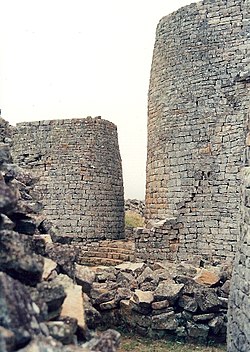History:Kingdom of Zimbabwe
Kingdom of Zimbabwe Zimbabwe | |||||||||||
|---|---|---|---|---|---|---|---|---|---|---|---|
| c. 1220–1450 | |||||||||||
| Capital | Great Zimbabwe | ||||||||||
| Religion | Belief in Mwari | ||||||||||
| Government | Monarchy | ||||||||||
| Mambo | |||||||||||
• c. 1220-? | Rusvingo (first) | ||||||||||
| History | |||||||||||
• Abandonment of Mapungubwe for Zimbabwe | c. 1220 | ||||||||||
• Zimbabwe conquest of Mutapa | 1430 | ||||||||||
• Abandonment of Zimbabwe for Mutapa | 1450 | ||||||||||
| ISO 3166 code | ZW | ||||||||||
| |||||||||||
The Kingdom of Zimbabwe (c. 1220–1450) was a medieval Shona kingdom located in modern-day Zimbabwe. Its capital, today's Masvingo (meaning Walls), which is commonly called Great Zimbabwe, is the largest stone structure in precolonial Southern Africa. This kingdom came about after the collapse of the Kingdom of Mapungubwe.
Name
The name "Zimbabwe" is Shona for "great house of stone", from the nouns 'Zimba-' meaning "great house" and 'ibwe' meaning "-stone". The Great Zimbabwe was the capital city of the kingdom that goes by the same name. The ruins are located in the country's south-east and are now a protected site. Two different theories address the origin of the word. "Zimbabwe" derives from Zimba-ra-mabwe or Zimba-re-mabwe, translated from the Karanga dialect of Shona as "houses of stones" (Zimba = augmentative noun of imba, "house"; mabwe = plural of ibwe, "stone"; ra/re = preposition for of).[1][2][3] The Kalanga-speaking Shona people live around Great Zimbabwe in the modern-day province of Masvingo. The archaeologist Peter Garlake claims that "Zimbabwe" represents a contracted form of dzimba-hwe, which means "venerated houses" in the Zezuru dialect of Shona and usually refers to a chief's houses or graves. However, it is now widely understood that the term "Zimbabwe" is not a contraction and that the name does not have a different meaning in Zezuru from in chiKaranga, both of which are dialects of Shona. Extensive archaeological evidence has also established that the many stone-walled edificies across the country had spiritual significance and were used or worshipped in addition to being the residence of royalty or nobility.[4]
History
Rise of Mutapa
Dating since at least the 15th century, the Mutapa state had once controlled the expanse of territory between the rivers Zambezi, Mazowe, Ruenya, Hunyani and the Umvukwe Range.[5]
In approximately 1430, Prince Nyatsimba Mutota from the Great Zimbabwe travelled north to the Dande region in search of salt. He then defeated the Tonga and Tavara with his army and established his dynasty at Chitakochangonya Hill. The land he conquered would become the Kingdom of Mutapa. Within a generation, Mutapa eclipsed Great Zimbabwe as the economic and political power in Zimbabwe. By 1450, the capital and most of the kingdom had been abandoned.
D.N. Beach in 2014 argued that "Because of the reluctance or inability of many researchers to work in Rhodesia and Mozambique in the last 15 years, the history of the Mutapa state has been heavily dependent upon the work of D.P. Abraham, at least as far as traditions are concerned."[5]
Aftermath
The end of the kingdom resulted in a fragmenting of proto-Shona power. Two bases emerged along a north–south axis. In the north, the Kingdom of Mutapa carried on and even improved upon Zimbabwe's administrative structure. It did not carry on the stone-masonry tradition to the extent of its predecessor. In the south, the Kingdom of Butua was established as a smaller, but nearly identical, version of Zimbabwe. Both states were eventually absorbed into the largest and most powerful of the Shona states, the Rozwi Empire.
Government
The social institution had a Mambo as its leader, along with an increasingly rigid three-tiered class structure. The kingdom taxed other rulers throughout the region. The kingdom was composed of over 150 tributaries headquartered in their own minor zimbabwes.[6] They established rule over a wider area than the Mapungubwe, the Butua or the Mutapa.
Economy and culture
The Kingdom of Zimbabwe controlled the ivory and gold trade from the interior to the southeastern coast of Africa. Asian and Arabic goods could be found in abundance in the kingdom's region. Economic domestication, which had been crucial to the earlier proto-Shona states, was also practiced. The Great Zimbabwe people mined minerals like gold, copper and iron. Cattle was important to the elites in the kingdom since their wealth came from the management of cattle.[7]
The rulers of Zimbabwe (called Mambo) brought artistic and stonemasonry traditions from Mapungubwe. The construction of elaborate stone buildings and walls reached its apex in the kingdom.
See also
- Kingdom of Butua
- Kingdom of Mutapa
- Khami
- Danan'ombe
References
- ↑ "Zimbabwe – big house of stone". Somali Press. http://www.somalipress.com/zimbabwe-overview/zimbabwe-big-house-stone-1145.html.
- ↑ Lafon, Michel (1994). "Shona Class 5 revisited: a case against *ri as Class 5 nominal prefix". Zambezia 21: 51–80. http://archive.lib.msu.edu/DMC/African%20Journals/pdfs/Journal%20of%20the%20University%20of%20Zimbabwe/vol21n1/juz021001005.pdf.
- ↑ Vale, Lawrence J. (1999). "Mediated monuments and national identity". Journal of Architecture 4 (4): 391–408. doi:10.1080/136023699373774.
- ↑ Garlake, Peter (1973). Great Zimbabwe: New Aspects of Archaeology. London, UK: Thames & Hudson. p. 13. ISBN 978-0-8128-1599-3. https://archive.org/details/greatzimbabwe0000garl.
- ↑ 5.0 5.1 Beach, D.N. (1976). "The Mutapa Dynasty: A Comparison of Documentary and Traditional Evidence". History in Africa 3: 1–17. doi:10.2307/3171558. https://www.cambridge.org/core/journals/history-in-africa/article/abs/mutapa-dynasty-a-comparison-of-documentary-and-traditional-evidence/C065666BD00E8A6A89A7FDD27FBA8500.
- ↑ Owomoyela 2002, p. 7.
- ↑ "Great Zimbabwe (11th–15th Century)". https://www.metmuseum.org/toah/hd/zimb/hd_zimb.htm.
Sources
- Peters, Carl (1902). The Eldorado of the Ancients. London: C. Arthur Pearson. https://archive.org/stream/eldoradoofancien00pete#page/392/mode/2up.
- Griffith, Francis Llewellyn (1903). Archæological Report. Egypt Exploration Fund. https://books.google.com/books?id=m3PSvXWaH5YC.
- Böhmer-Bauer, Kunigunde (2000). Great Zimbabwe: eine ethnologische Untersuchung. R. Köppe. ISBN 389645210X. https://books.google.com/books?id=V9EwAQAAIAAJ.
- Oliver, Roland & Anthony Atmore (1975). Medieval Africa 1250–1800. Cambridge: Cambridge University Press. pp. 738. ISBN 0-521-20413-5. https://archive.org/details/cambridgehistory04fage/page/738.
- Owomoyela, Oyekan (2002). Culture and Customs of Zimbabwe. Westport: Greenwood. ISBN 978-0-313-31583-1. https://archive.org/details/culturecustomsof00owom.
- Stewart, John (1989). African States and Rulers. Jefferson: McFarland. pp. 395. ISBN 0-89950-390-X. https://archive.org/details/africanstatesrul0000stew.
- Wieschhoff, H. A. (2006). The Zimbabwe-Monomotapa Culture in Southeast Africa. Whitefish: Kessinger. p. 116. ISBN 1-4286-5488-7. https://books.google.com/books?id=in_dL8e7pwgC.
Further reading
- Cartwright, M. (14 March 2019). Great Zimbabwe. World History Encyclopedia
 |



